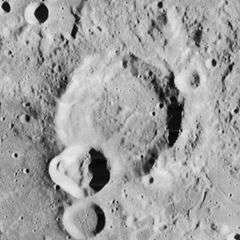Cavendish (crater)
Cavendish is a lunar impact crater that is located in the southwest part of the Moon, to the southwest of the larger crater Mersenius. It lies between the smaller craters Henry to the west-northwest and de Gasparis to the east-southeast.
 Cavendish crater image | |
| Coordinates | 24.5°S 53.7°W |
|---|---|
| Diameter | 56 km |
| Depth | 2.4 km |
| Colongitude | 54° at sunrise |
| Eponym | Henry Cavendish |
The rim of Cavendish is heavily worn and the crater Cavendish E lies across the southwest rim. The smaller Cavendish A is intruding into the northeast rim. On the flood are a pair of low-rimmed craters that are joined at the rims and span most of the central Cavendish crater floor from east to west.
A rille from the Rimae de Gasparis reaches the eastern rim of Cavendish.
Satellite craters
By convention these features are identified on lunar maps by placing the letter on the side of the crater midpoint that is closest to Cavendish.
| Cavendish | Latitude | Longitude | Diameter |
|---|---|---|---|
| A | 24.0° S | 52.7° W | 10 km |
| B | 23.2° S | 55.1° W | 10 km |
| E | 25.4° S | 54.2° W | 24 km |
| F | 26.1° S | 54.0° W | 18 km |
| L | 21.7° S | 53.6° W | 5 km |
| M | 22.0° S | 53.8° W | 6 km |
| N | 22.1° S | 54.3° W | 4 km |
| P | 24.2° S | 51.6° W | 4 km |
| S | 23.8° S | 52.4° W | 5 km |
| T | 24.8° S | 55.2° W | 4 km |
References
- Andersson, L. E.; Whitaker, E. A. (1982). NASA Catalogue of Lunar Nomenclature. NASA RP-1097.CS1 maint: ref=harv (link)
- Blue, Jennifer (July 25, 2007). "Gazetteer of Planetary Nomenclature". USGS. Retrieved 2007-08-05.CS1 maint: ref=harv (link)
- Bussey, B.; Spudis, P. (2004). The Clementine Atlas of the Moon. New York: Cambridge University Press. ISBN 978-0-521-81528-4.CS1 maint: ref=harv (link)
- Cocks, Elijah E.; Cocks, Josiah C. (1995). Who's Who on the Moon: A Biographical Dictionary of Lunar Nomenclature. Tudor Publishers. ISBN 978-0-936389-27-1.CS1 maint: ref=harv (link)
- McDowell, Jonathan (July 15, 2007). "Lunar Nomenclature". Jonathan's Space Report. Retrieved 2007-10-24.CS1 maint: ref=harv (link)
- Menzel, D. H.; Minnaert, M.; Levin, B.; Dollfus, A.; Bell, B. (1971). "Report on Lunar Nomenclature by the Working Group of Commission 17 of the IAU". Space Science Reviews. 12 (2): 136–186. Bibcode:1971SSRv...12..136M. doi:10.1007/BF00171763.CS1 maint: ref=harv (link)
- Moore, Patrick (2001). On the Moon. Sterling Publishing Co. ISBN 978-0-304-35469-6.CS1 maint: ref=harv (link)
- Price, Fred W. (1988). The Moon Observer's Handbook. Cambridge University Press. ISBN 978-0-521-33500-3.CS1 maint: ref=harv (link)
- Rükl, Antonín (1990). Atlas of the Moon. Kalmbach Books. ISBN 978-0-913135-17-4.CS1 maint: ref=harv (link)
- Webb, Rev. T. W. (1962). Celestial Objects for Common Telescopes (6th revised ed.). Dover. ISBN 978-0-486-20917-3.CS1 maint: ref=harv (link)
- Whitaker, Ewen A. (1999). Mapping and Naming the Moon. Cambridge University Press. ISBN 978-0-521-62248-6.CS1 maint: ref=harv (link)
- Wlasuk, Peter T. (2000). Observing the Moon. Springer. ISBN 978-1-85233-193-1.CS1 maint: ref=harv (link)
